
Knutsford Ornithological Society Holiday in Scotland - 7th to 14th June 2017
Twelve members headed north for our week in and around Speyside based at the Grant Arms Hotel in the centre of the picturesque town of Grantown-on Spey. Over the past few years the Hotel has been refurbished to a high standard and in addition to the "normal" type of visitors attracted to this part of the world they have chosen to target folk like us and offer extensive facilities to people with an interest in natural history. To this end a bird watching and wildlife club is based in the hotel offering free guided walks, talks, briefings and films additionally a number of commercial organisations with whom they have a symbiotic relationship offer, for a fee of course, fully guided holidays and day trips.
Our hard-working Chairman Sheila Blamire had booked our accommodation well in advance and secured very favourable terms on our behalf - bed, breakfast and evening meals; the food was excellent with only the odd grumble - unusual for the KOS!
Most of our party had visited the area before, so we we're well aware that a fixed itinerary wasn't the way to go - we had a list of locations that we'd like to explore but up here you're at the mercy of the Scottish weather!
Day #1 Wednesday 7th June - Travel
Most members travelled today, although Derek and Jean took things a little more leisurely and stopped overnight at Biggar at the northern end of the southern uplands; including a couple of stops the direct journey took us around seven hours. We had decided to begin our trip list as soon as we crossed into Scotland - the usual loose KOS rules applied - any bird seen or heard by any member of the party with a target of 100 species for the week (it's only bird watching: no one dies!). By the end of the day we'd accumulated 46 species - a solid enough start.
After the evening meal some of the party attended a lecture arranged by the BWCC given by Professor David Parkin on the subject of bird ringing - from the early days to today and the use of geo-tags and satellite technology - excellent! Looking him up on the web the following information came to light .....he remained there for the rest of his academic career, gradually rising through the ranks to Professor of Avian Genetics. Specialising in evolutionary genetics, his research group was at the forefront of applying biochemical and molecular technology to the study of bird populations.... It would cost us a bob or two to get him down to Knutsford for one of our evening talks! I think he enjoyed talking to some "real" bird watchers rather than casual hotel visitors and when he'd finished revealed that during the day he'd come across a party of Dutch birders who had discovered a Woodchat Shrike along the Findhorn Valley! He gave us precise directions - so that was tomorrow sorted!!
Day #2 Thursday 8th June. Findhorn Valley, Farr Road, Loch Ruthven.
The Findhorn Valley is accessed from the A9 turning to the left just before the Findhorn bridge and following the narrow road for a distance of nine miles towards 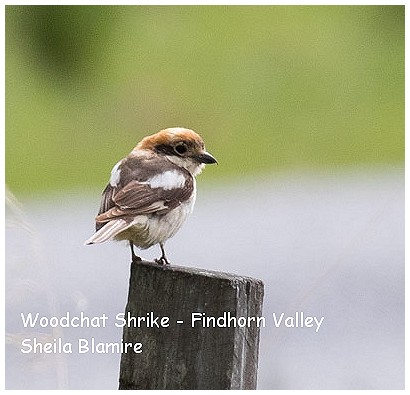 Coignfearn where there is a car park. The best approach is to simply drive slowly along stopping at any convenient spot to give the location a coat of looking at; the Findhorn river is in view for most of the route. Coignfearn where there is a car park. The best approach is to simply drive slowly along stopping at any convenient spot to give the location a coat of looking at; the Findhorn river is in view for most of the route.
Mistle Thrushes and Willow Warblers were very common in the wooded areas, along the river Common Sandpipers, Common Terns and Dippers were noted and over the hill tops our first Red Kite of the week.
Following the professor's directions we arrived at the spot where the shrike had been seen the previous day; there were already some birders in attendance - and there it was! A first summer female apparently and showing very well - all the party had satisfactory views, as you can see Sheila caught it on film (as we used to say) and Geoff obtained some excellent video showing the bird ejecting a pellet.
Moving on to the car park previously mentioned 'scopes were set up and the search for an eagle began, Buzzards and Ravens appeared over the surrounding hills and eventually our patience was rewarded when a Golden Eagle at last appeared hanging in the air over some woodland, legs dangling in a characteristic manner - distant views but with the aid of the 'scopes good enough for positive identification.
From the valley we made our way over the hills via the Farr road to Loch Ruthven, pausing on the way to watch a family party of Red Grouse feeding at the roadside. We had hoped to see the Ruthven Slavonian Grebes but unfortunately the recent heavy rain had flooded the nest and the birds were nowhere to be seen. We did though see Tree Pipit, Little Grebe, Tufted Duck, Reed Bunting and Red-throated Diver so it wasn't a wasted journey and we were able to add 17 new species to our trip list
Day #3 Friday 9th June - The Moray Coast
The weather forecast wasn't good for Friday but it seemed there would be less chance of rain along the Moray coast, so we headed north starting at the village of Findhorn on the shores of Findhorn Bay where the river of the same name empties into the north sea. 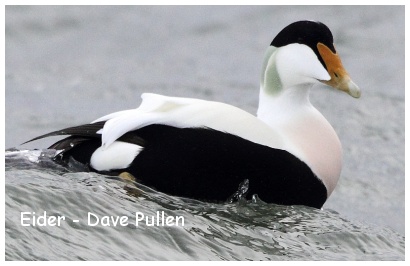 Just a few showers but it was cool and very windy nevertheless a short period of sea watching produced some new species including Sandwich Tern, Kittiwake and Gannet. A Hooded Crow on the roof of a cafe proved to be the only one of the week whilst in the harbour a group of Red-breasted Mergansers loafed on the mud next to the river. A tangle of gorse bushes gave us Linnet and Stonechat. Just a few showers but it was cool and very windy nevertheless a short period of sea watching produced some new species including Sandwich Tern, Kittiwake and Gannet. A Hooded Crow on the roof of a cafe proved to be the only one of the week whilst in the harbour a group of Red-breasted Mergansers loafed on the mud next to the river. A tangle of gorse bushes gave us Linnet and Stonechat.Burghead harbour produced Eider, Rock Pipit and a nice flock of Common Scoters in a tight flock of around 60 birds just outside the shelter of the harbour in the open sea. Moving east to Lossimouth we found the first waders of the holiday with a few Dunlin and a single Ringed Plover on a stretch of sandy beach on the outskirts of the town. The final, and best, location of the day was Spey Bay home to the Scottish Dolphin Centre run by the Whale and Dolphin Conservation Society. Two Ospreys were hunting, circling slowly over the river, eventually one of the pair was successful and made off with it's prize pursued by a noisy mixture of terns and gulls. There's a small area of wetland, overgrown with reed and willow, to the rear of the centre this held singing Sedge and Grasshopper Warblers with our first Greenfinch wheezing from a nearby hedge. After a welcome coffee in the cafe we made our way back to Grantown having added 21 new species to the ever expanding trip list.
Day #4 Saturday 10th June - Loch Garten, Loch Malachie, Avielochan, Craigellchie NNR
Light rain for the first couple of hours on the Saturday as we made our way over to Loch Garten, parking in the reserve car park then walking along the loch side road before moving into the pine woods and along the tracks leading down to Loch Malachie, a distance of 2Km. 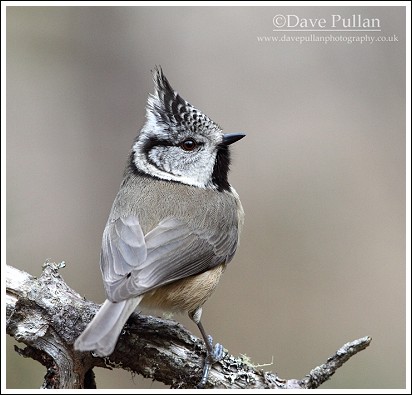 A good start as we left the car park with a nice male Redstart showing fleetingly and a family of Goldeneye on the loch but the woodland was relatively quiet with only a Treecreeper and Tree Pipit of interest; no sign of the Crested Tits we'd hoped for. A good start as we left the car park with a nice male Redstart showing fleetingly and a family of Goldeneye on the loch but the woodland was relatively quiet with only a Treecreeper and Tree Pipit of interest; no sign of the Crested Tits we'd hoped for.
Malachie was as peaceful as ever - one of Speyside's best kept secrets and a favourite with more than one member of the party - I thought we may have had to drag the Hon. Treasurer away!.Although the Garten Ospreys had failed this year the information centre was attracting a steady stream of visitors and those that made their way up the path were well rewarded with a Crested Tit on one of the feeders! We had met up with ex Cheshire resident and keeper of the CAWOS website Mike Hemms who now lives in the area and spends a lot of time as a volunteer on the reserve. He had seen a Crested Tit on only four occasions this season so our luck was in. Things got even better though as the ever alert Bob Groom picked out a Crossbill at the top of one of the pines near to the feeders - a real bonus - 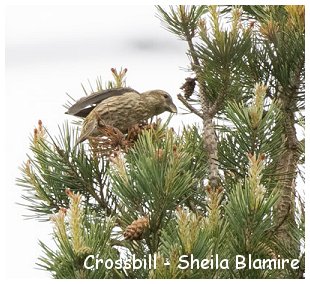 well done Robert!! well done Robert!! Our second port of call for the day was the private hide run by the BWWC at Avielochan where the resident Slavonian Grebes showed well for us and kept us entertained as we enjoyed a lunch break. Finally we headed for Aveimore and the Craigellachie NNR where we hoped for Pied Flycatcher and Wood Warbler, despite a strenuous hike up the hillside there was no sign or sound of the flycatchers but a Wood Warbler obliged - still in song despite the late date - heard only but not seen. A good day with 11 new species for the trip list but things went downhill somewhat later! We were having an earlier than normal evening meal so missed the last few minutes of the Scotland v England World Cup qualifier it was 0-1 when we sat down to eat but ended up at 2-2 a few minutes later - what's that all about?! Some of the party had arranged to travel over to a location close to Loch an Eilein where we'd paid 25 quid each for a close-up view of pine martins from a specially constructed hide. In the event, and to cut a long story short, we sat for three hours in the gathering gloom gazing at a bird table holding a few peanuts and an egg - no sign of any martins just a couple of snuffling badgers. Yes I know they're wild animals!
Day #5 Sunday 11th June - Cairngorm, Loch Morlich, Lochindorb
Mixed weather to start with and steady rain as we pulled into the car park next to the bottom of the funicular railway and the chairlift facilities - we were in the clouds!
The railway is brilliant, whisking up to 120 people up to the Ptarmigan restaurant, at over 3,500 feet, in eight minutes at a leisurely 11mph (in winter it runs at twice the speed [22mph] when conveying skiers up the mountain). Facilities at the top are good, as well as the restaurant there is an exhibition and shop plus a large viewing terrace giving wide ranging views of the immediate area and away into the distance to Aveimore and beyond.Birds were few 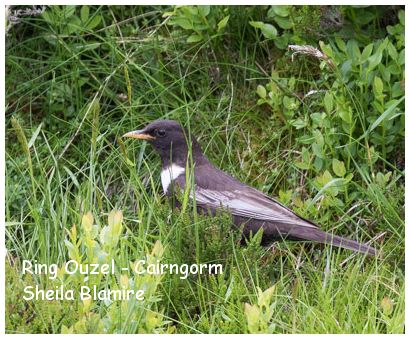 and far between, Ptarmigan, Dotterel and Snow Buntings are apparently seen on a regular basis but on the day we had only Snow Bunting - a single bird seen by some of the party for a few moments before vanishing over a ridge not to be seen again. Nevertheless at
£13:50 it was an interesting morning and excellent value when compared to the previous evenings
£12:50 per badger! Back at the car park a pleasant surprise as Len Mason came across a family party of Ring Ouzels, the parent birds and two well grown young quite unperturbed by the coming and goings around them. Close up views of this increasingly rare member of the Thrush family. and far between, Ptarmigan, Dotterel and Snow Buntings are apparently seen on a regular basis but on the day we had only Snow Bunting - a single bird seen by some of the party for a few moments before vanishing over a ridge not to be seen again. Nevertheless at
£13:50 it was an interesting morning and excellent value when compared to the previous evenings
£12:50 per badger! Back at the car park a pleasant surprise as Len Mason came across a family party of Ring Ouzels, the parent birds and two well grown young quite unperturbed by the coming and goings around them. Close up views of this increasingly rare member of the Thrush family. From Cairngorm we drove a short distance down to the shores of Loch Morlich where we met up with our old friend from the days of Operation Osprey Dave Pullan - the quiet man of the mountains now running his own successful guiding and wildlife photography company. Just a single Red-throated Diver on the loch so we decided to make our way over to Lochindorb for Black-throated Diver. This is the place for the species it's never let us down over the years - until now of course! Talking to a local farmer it transpired that the recent heavy rain had caused the water level to rise by three feet, sounds a lot but he seemed to be very familiar with the area, anyway the nest and eggs had been lost together with those of the Common Sandpipers also nesting on the shore. So that was it and we never did find a Black-throated Diver - you can't win 'em all!
Day #6 Monday 12th June - Chanonry Point, Udale Bay, Dornoch Lodge.
Quite a long drive on Monday morning, but very interesting of course - as are all journeys in this part of the world, taking us over the magnificent cable-stayed Kessock bridge with views of the Tulloch Caledonian Stadium, home of Inverness Caledonian Thistle Football club,  this must be the best view from any football ground in the UK - the bridge on one side and the Beauly Firth on the other. this must be the best view from any football ground in the UK - the bridge on one side and the Beauly Firth on the other.Our timing was spot on, the tide was rising and already the shore was lined with spectators marvelling at the antics of the Bottlenosed Dolphins just a few yards from where they stood. There must have been about a dozen, occasionally one would throw a salmon high into the air or, once or twice, leap clear of the water prompting a frenzy of activity from the photographers, motor drives whirring (although I guess it's not referred to as motor drive in this digital age - perhaps burst or continuous mode!).
Not much in the way of birds, Swallows flew low over the seaweed along the high tide line picking off insects, Dunnocks and Yellowhammers lurked in the gorse bushes and Len and Bob managed a Guillemot - our first of the week. From Chanonry Point we drove the short distance across the Black Isle to the RSPB's Udale Bay reserve, a well equipped roadside hide looked over the Cromarty Firth towards the town of Invergordon. An Osprey hunted in the distance, Red Kite and Raven approached a little closer and we did get two new species in the form of a Peregrine and three Pink-footed Geese who hadn't journeyed north in the spring for one reason or another. Finally it was back to Speyside where we met up again with Dave Pullen who took us to a spot near Dornoch Lodge, 'scopes were set up and in steadily deteriorating weather a determined search revealed three Black Grouse way in the distance - most people got onto them, it wasn't easy but met the criteria and they represented species number #106. #107 was a lot easier as a Lesser Redpoll flew overhead calling loudly in what was now a steady penetrating drizzle.
Day #7 Tuesday 13th June - Insh Marshes, Loch an Eilein, Loch Garten
We had a couple of options for the final day's birding, a return to Spey Bay had been suggested but in the end those that wanted to go again to Loch Garten for better views of the Crested Tits won the day and we would combine this with visits to the Insh Marshes and Loch an Eilein.
 The marshes cover a huge area but the three hides give good coverage, especially the new double decker with a conventional affair below and viewing platform situated above. Very impressive, the RSPB are spending plenty of money in Scotland! Young Curlews were seen below the hides and Lapwings also had chicks judging by their agitated behaviour, single Sedge Warblers and Reed Buntings were in song and a lone Snipe dropping into one of the pools was a new one. Other than this the marsh was quiet, predictable given the time of the year. The marshes cover a huge area but the three hides give good coverage, especially the new double decker with a conventional affair below and viewing platform situated above. Very impressive, the RSPB are spending plenty of money in Scotland! Young Curlews were seen below the hides and Lapwings also had chicks judging by their agitated behaviour, single Sedge Warblers and Reed Buntings were in song and a lone Snipe dropping into one of the pools was a new one. Other than this the marsh was quiet, predictable given the time of the year.
We drove to the end of Loch Insh and from the churchyard had great views of the well known resident Ospreys, the female was mantling the nest protecting the chicks from a heavy rain shower. On the way to this site Frank's car (or more correctly it's occupants!) added two new species, a Sparrowhawk and a Green Woodpecker - a good bird to finish with as it's quite rare in Speyside.
Loch an Eilein was also quiet, it's very picturesque but apart from a singing Redstart a walk along the water side revealed nothing of interest.
Both the Crossbills and Crested Tits failed to put in an appearance outside the Loch Garten complex but it was nice to spend a couple of hours there relaxing at the end of our last day in a wonderful part of the world.We ended up with a total of 110 species easily passing our target of 100 over the seven days but of course it's about more than that, having an aim adds interest and keeps people on their toes but at the end of the day did everyone enjoy their week in Scotland? I think they did - some good birds , plenty of banter and laughs of course and a chance to meet up with friends like Dave and Mike - not forgetting Richard Thaxton another friend from the days of Operation Osprey now retired from the RSPB but spending his time leading tours all around the world - New Zealand from North to South in November this year - it's a tough job Richard but someone has to do it!! It goes without saying that our thanks go to Sheila for putting so much time and effort into the holiday - researching the various venues and fitting them in around the weather. Finally - a society like ours is only as good as its members so thanks to all participants - you're a great team!
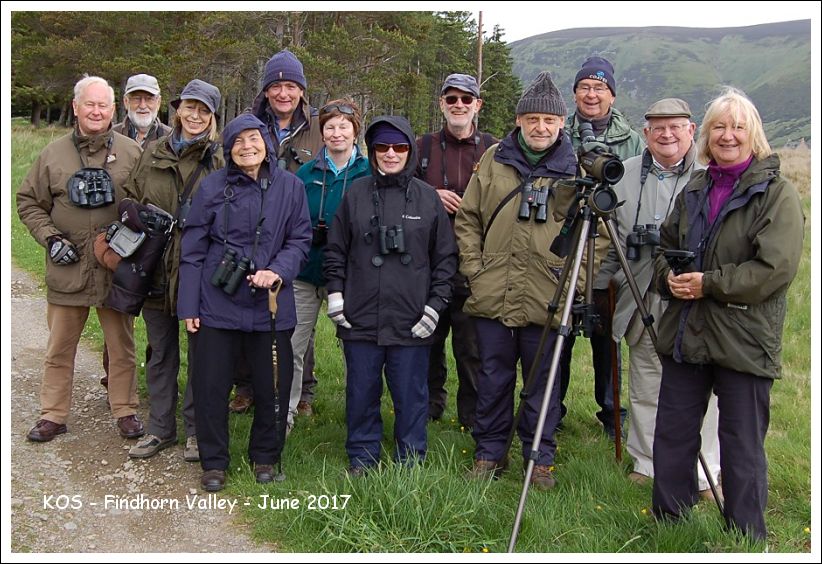
Species recorded in Scotland 7th to 14th June 2017
Mute Swan, Pink-footed Goose, Greylag Goose, Canada Goose, Shelduck, Mandarin Duck, Teal, Mallard, Tufted Duck, Eider, Common Scoter, Goldeneye, Red-breasted Merganser, Red Grouse, Black Grouse, Red-legged Partridge, Pheasant, Red-throated Diver, Little Grebe, Great Crested Grebe, Slavonian Grebe, Gannet, Cormorant, Heron, Red Kite, Sparrowhawk, Buzzard, Golden Eagle, Osprey, Kestrel, Peregrine, Oystercatcher, Ringed Plover, Lapwing, Dunlin, Snipe, Curlew, Redshank, Common Sandpiper, Black-headed Gull, Common Gull, Lesser Black-backed Gull, Greater Black-backed Gull, Herring Gull, Kittiwake, Sandwich Tern, Common Tern, Guillemot, Feral Pigeon, Woodpigeon, Collared Dove, Tawny Owl, Green Woodpecker, Great Spotted Woodpecker, Skylark, Sand Martin, Swallow, House Martin, Swift, Tree Pipit, Meadow, Rock Pipit, Grey Wagtail, Pied Wagtail, Dipper, Wren, Dunnock, Robin, Redstart, Stonechat, Wheatear, Ring Ouzel, Blackbird, Song Thrush, Mistle Thrush, Grasshopper Warbler, Sedge Warbler, Blackcap, Wood Warbler, Chiffchaff, Willow Warbler, Goldcrest, Spotted Flycatcher, Long-tailed Tit, Crested Tit, Coal Tit, Great Tit, Blue Tit, Treecreeper, Jay, Magpie, Jackdaw, Rook, Hooded Crow, Carrion Crow, Raven, Starling, House Sparrow, Chaffinch, Greenfinch, Goldfinch, Siskin, Linnet, Lesser Redpoll, Common Crossbill, Bullfinch, Snow Bunting, Yellowhammer, Reed Bunting, Woodchat Shrike
[ ✓ 110]
|
|